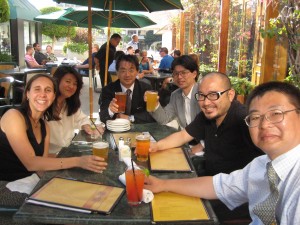By Stacy Smith (Kumamoto-ken CIR, 2002-03) for JQ Magazine
Since becoming a freelance Japanese translator/interpreter/writer, one of the opportunities that I have enjoyed the most has been interpreting for the Department of State’s International Visitor Leadership Program (IVLP). IVLP is an exchange program designed to build mutual understanding between the U.S. and other countries through carefully designed visits that reflect the participants’ (the titular IVs) professional interests and to support U.S. foreign policy goals. For IVs, it involves meeting professional counterparts and learning to appreciate America’s ethnic, cultural, political and socioeconomic diversity.
IVs are established or potential foreign opinion makers in government, public policy, media, education, labor, the arts and other key fields, and after being nominated by someone they are selected by American embassies abroad. Since the program’s inception in 1940, there have been over 140,000 participants (about 5,000 each year), including 290 current and former heads of government such as Tony Blair and several Japanese prime ministers.
However, here in the States all IVs are considered “honorary Americans.” This means that no matter what their rank is back home, during the program everyone is of equal status. This takes quite a bit of pressure off the lowly interpreter (who of course has hopes of being fondly remembered when her former participants go on to become big shots!).
Although different in nature, IVLP makes me feel like I’m continuing the work I did on JET in a new realm. As a coordinator for international relations (CIR) at Kumamoto City Hall, I was involved with our sister city San Antonio, and would guide Texan groups as well as other visitors during their stay. I also interpreted at various international events, thereby serving as both a linguistic and cultural bridge between Eastern and Western cultures. In my current role as an IVLP interpreter I also perform these dual functions, so I often think back to my JET days and how they helped bring me to where I am today.
I began this work a year ago, and have completed six assignments since then. The themes have ranged from disaster prevention to female entrepreneurship to prison management, and IVs have come from all walks of life (lawyers, professors, shachos, civil servants, etc.) as well as locations ranging from Shimane to Hokkaido. The programs are typically three weeks in duration, kicked off by a week in D.C. and concluded with a short stay on the West Coast.
In between, there are stops in three or so cities that are selected with the purpose of incorporating geographic diversity (like with JET, IVs can submit the destinations they desire). They meet with groups like federal, state and local government agencies, NPOs and corporations, and are also able to visit with average Americans through something called Home Hospitality. This involves having a meal at someone’s house or going out to dinner with the family at a local restaurant. If requested, one-night homestays can also be arranged in one of the cities.
As an interpreter, this is one of the most fulfilling jobs I have. As three weeks on the road is admittedly a long haul and the program is not just 9 to 5, it is not for everyone. However, the IVs are encouraged to get out and explore on their own as much as possible, allowing them to make their own discoveries and give the interpreter a much-needed break. For someone who loves traveling as much as I do, this kind of work is ideal. I feel extremely lucky to be able to go all around the country, meeting many kinds of people and seeing new places that I would not have had the opportunity to be exposed to otherwise. It’s a bonus to take IVs to places as amazing as the Grand Canyon and Frank Lloyd Wright houses across the country!
Professionally, with a different theme each time there is extensive preparation and research that must take place before the assignment even begins. In this way, I’m able to develop a solid base of new Japanese and English vocabulary which at the start may not be familiar, but becomes like second nature by the end. I come away with a significant awareness of an area that mostly was previously unknown. Especially in the beginning of the program, I often spend nights preparing for the next day’s meetings, making me feel like I’m back in school! However, this time around the payoff is greater than a high test grade; I am facilitating both professional communication and informal exchange to enhance the IVs’ experience. After my time with the prison management group, they teased me that I’m probably the only person who can give bilingual lectures on both countries’ prison systems who’s also had firsthand experience at such infamous federal and state correctional facilities as Leavenworth and San Quentin!
One of my favorite aspects of my chosen profession is learning about a wide variety of topics and interacting with different people, making me a perfect fit for IVLP. This program is a use of taxpayer dollars that few people know about, but I think it’s a wonderful example of grassroots international exchange (sound familiar?) and soft power that will benefit America’s future relationship with the world. I just received word that the theme of my next IVLP assignment is human trafficking, which promises another exciting trip and the chance to delve into a completely new field.
For more on the International Visitor Leadership Program, visit http://exchanges.state.gov/ivlp/ivlp.html.
Read Stacy’s WITLife columns at http://jetwit.com/wordpress/category/wit-life.



one comment so far...
[…] 2009 Fall – International Visitor Leadership Program interpreting (shows how JETs can become invaluable interpreters to continue grassroots internationalization at home) by Stacy Smith […]